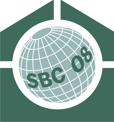
About
SBTool 07
available here for downloading for academic or research purposes.
SBTool, formerly known as GBTool, is designed to assess the
environmental and sustainability performance of buildings.
SBTool is the software
implementation of the Green Building Challenge (GBC) assessment
method that has been under development since 1996 by a group
of more than a dozen teams. The GBC process was launched by Natural
Resources Canada, but responsibility was handed over to the International
Initiative for a Sustainable Built Environment (iiSBE) in 2002.
Elements of the SBTool system.
-
SBT07-A is used by regional third-party organizations to establish
scope, eligible occupancy types, and locally valid
weights, benchmarks and standards;
- SBT07-B allows
designers to provide information about the site and
project characteristics;
-
SBT07-C
is used to carry out self-assessments that are based
on the data entered in the A and B files.
Features of SBTool.
- SBTool is a generic framework for rating the sustainable performance of buildings and projects. It may also be thought of as a toolkit that assists local organizations to develop rating systems.
- The system covers a wide range of sustainable building issues, not just green building concerns, but the scope of the system can be modified to be as narrow or as broad as desired, ranging from 125 criteria to half a dozen;
- The system allows third parties to establish parameter weights that reflect the varying importance of issues in the region, and to establish relevant benchmarks by occupancy type, in local languages. Thus, many rating systems can be developed in different regions that look quite different, but share a common methodology and set of terms. The main advantage, however, is that an SBTool version developed with local knowledge is likely to be much more relevant to local needs and values than other systems;
- Although the current version is set up to carry out Design-stage assessments only, the system has the capacity to carry out assessments at four distinct stages of the life-cycle and provides default benchmarks suited to each phase;
- Local organizations can select up to three building types out of a total of 18, and apply them separately or in a mixed-use project;
- SBTool takes into account region-specific and site-specific context factors, and these are used to switch off or reduce certain weights, as well as providing background information for all parties.
- The system handles large projects or single buildings, residential or commercial, new and existing construction, or a mix of the two;
- The system can provide approximations of annualized embodied energy for structural and building envelope components.
- Designers can specify performance targets and can score self-assessed performance;
-
Assessors can accept self-assessed performance scores
submitted by designers, or can modify them.
Users of this software should be aware of the following limitations and conditions:
- The system is a framework, not a simulation model. Users are expected to use other software tools to simulate energy performance, estimate embodied energy and emissions, predict thermal comfort and air quality etc.
- An important design feature of the system is that the characteristics of a Design is compared to Benchmark values, and that the features of the Design are then scored and weighted. Results are meaningless unless the given national team has first established the benchmark values, adjusted scoring guides and adjusted the weights, so they are relevant to its region.
![]() IMPORTANT
NOTE! Click here before
downloading
IMPORTANT
NOTE! Click here before
downloading ![]()
| SBTool
07 and Current Notes
|
The current version of the system is SBTool June 1, 2007.
|
|
|
Notify
Webmaster about any downloading problems
at: kujawski@magma.ca
|